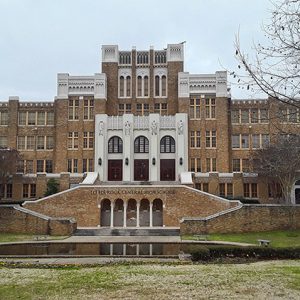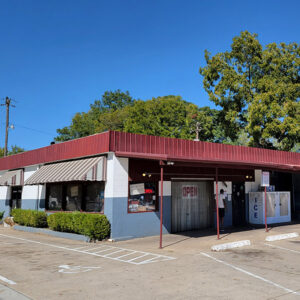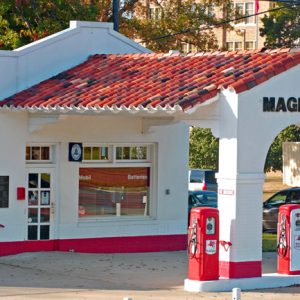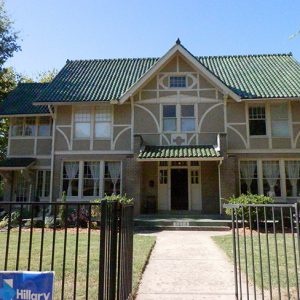calsfoundation@cals.org
Central High School Neighborhood Historic District
Made nationally famous during the 1957 desegregation crisis, Central High School in Little Rock (Pulaski County) is surrounded by a historic neighborhood district that also bears its name. Central High is both an active high school and a museum protected under the National Park Service as a National Historic Landmark. The surrounding historical district is primarily made up of residential structures and is divided by Wright Avenue, a road historically used by trolleys. Residences in this neighborhood display primarily the Craftsman Bungalow, Tudor Revival, and Colonial Revival styles.
The original district—roughly bounded by Dr. Martin Luther King Jr. Drive on the east, Thayer Avenue on the west, West 12th Street on the north, and Roosevelt Road on the south—was added to the National Register of Historic Places on August 16, 1996. At that time, there were 824 buildings included in the district, 796 of which were residential. The district also included four schools, two churches, and twenty-two commercial buildings.
Development in the area happened mainly during two specific time periods. From 1900 to 1914, 316 of the buildings (thirty-eight percent) were constructed. Following World War I, 1920 to 1930 saw a boom in construction, and an additional 274 buildings (thirty-three percent) were erected. The remaining 234 structures (twenty-nine percent) were built later. In the period following World War I, the area was characterized as “a capital place for a picnic and big enough for half the families of town to go at once without disturbing each other.”
Author Dee Brown spent much of the 1920s living on Schiller Street and talked about the diversity of the West End section of the neighborhood in his memoir When the Century Was Young. In the 1940s, this district was considered to be similar in value to the Heights and Hillcrest neighborhoods. The district in the twenty-first century is said to offer a representative view of the middle- and working-class homes in Little Rock from the 1900s to the 1930s.
After World War I and again in the 1960s, the area was affected by white flight, when white residents chose to move farther west instead of living in racially integrated neighborhoods. This movement undermined the district’s “stability, character and reputation,” according to the National Register of Historic Places nomination form, but the most significant factor threatening “the neighborhood’s architectural integrity is deterioration due to transient residents, inadequate maintenance, demolition necessitated by deterioration, the modification of homes to accommodate larger numbers of families, and the prevalent application of artificial siding.”
One particularly significant structure included in the district, across the street from Central High, is the Magnolia/Mobil Gas Station, which served as a staging site for media representatives during the 1957 crisis; it later became an education center for the museum. Like Central High, the Magnolia Station was built in the 1920s, and it remained an operating gas station until the 1980s. It was used for storage until 1996, when it was restored to its 1957 appearance.
Another significant presence in the neighborhood is the longstanding black-owned business K. Hall and Sons. The Hall family is listed in the Arkansas Black Hall of Fame.
In 1998, President Bill Clinton signed legislation designating Little Rock Central High School National Historic Site as a unit of the National Park Service. Central High Museum, Inc., donated the property to the park service, and the Magnolia Station was used as a visitors’ center until 2007, when a larger, permanent center opened for the fiftieth anniversary commemorating the Little Rock Nine’s entrance into Central High.
In 2012, the boundaries of the district were expanded to include West 17th Street, Dr. Martin Luther King Jr. Drive, Wright Avenue, South Summit, and South Battery. This expansion was designated to include newer structures, increasing the range of architectural diversity. This new area would be “representative of the evolution of a middle-class, interracial, mixed-use neighborhood throughout the early to mid-twentieth century,” the expansion application explained. The expansion included the John F. Weinmann House, listed on the National Register of Historic Places in 2012.
In its first designation, the neighborhood included St. Bartholomew Catholic Church, the Centennial School (all that remains of the school is the staircase and archway/front entrance that stands at the entrance to Centennial Park), the Main Building of Arkansas Baptist College (listed on the National Register on April 30, 1976), West Side Junior High School, and the James Mitchell School.
The newer boundaries included six additional commercial buildings, the gymnasium building on the Arkansas Baptist College campus, and the Pilgrim Valley Baptist Church. Most of the construction in the expanded area took place after World War I, with forty-four of the fifty-four contributing structures built from 1920 to 1961. The Henry Clayborn House, included in the newer boundaries, had already been listed on the National Register of Historic Places on May 24, 2006.
The Central High neighborhood is laid out in a standardized grid pattern, with only one exception, found in the 2000 block of South Battery Street. A much larger flower garden was originally planned for this space, but the area became simply a grassy median spanning the length of the block.
Although this area is most widely known for the 1957 crisis, eighty-six percent of the structures were already built ten years before the desegregation of Central High brought national attention to the neighborhood. Most of the area is in fair or good condition in the twenty-first century. Some portions of the district have deteriorated, however, and a few properties have been abandoned and left in poor condition. To remain recognized as a historic district, a neighborhood needs to retain fifty-one percent of its historic fabric; by 2022, the ratio in the Central High neighborhood had dropped to about fifty-nine percent.
At a Little Rock Board of Directors meeting on November 15, 2022, directors set a date for a public hearing on the possibility of establishing a Local Ordinance District for the Central High neighborhood, which would provide aid to homeowners to preserve the historic buildings they own. In March 2023, the Little Rock Board of Directors voted against establishing the ordinance, citing community opposition. Preserve Arkansas, in May 2023, placed the district on its Most Endangered Places list.
For additional information:
Bowden, Bill. “Nonprofit Releases ’23 List of Endangered Historic Locales.” Arkansas Democrat-Gazette, May 18, 2023, pp. 1B, 5B. Online at https://www.arkansasonline.com/news/2023/may/18/three-properties-named-to-arkansas-most/ (accessed May 18, 2023).
“Central High School Neighborhood Historic District.” National Register of Historic Places registration form. On file at Arkansas Historic Preservation Program, Little Rock, Arkansas. Online at https://www.arkansasheritage.com/arkansas-historic-preservation-program (accessed November 21, 2022).
“Central High School Neighborhood Historic District (Boundary Increase 2).” National Register of Historic Places registration form. On file at Arkansas Historic Preservation Program, Little Rock, Arkansas. Online at https://www.arkansasheritage.com/arkansas-historic-preservation-program (accessed November 21, 2022).
Dodds, Paul. “Central High Historic District Could Soon Be History.” Arkansas Times, November 1, 2022. https://arktimes.com/arkansas-blog/2022/11/01/central-high-historic-district-could-soon-be-history (accessed November 1, 2022).
Flaherty, Joseph. “Stricter Status for Central High Area Fails.” Arkansas Democrat-Gazette, March 8, 2023, p. 2B. Online at https://www.arkansasonline.com/news/2023/mar/08/little-rock-city-board-rejects-measures-to-create/ (accessed March 8, 2023).
Hennigan, Mary. “Little Rock Moves One Step Closer to Regulated Protections for Central High Historic Neighborhood.” Arkansas Times, November 21, 2022. https://arktimes.com/arkansas-blog/2022/11/21/little-rock-moves-one-step-closer-to-regulated-protections-for-central-high-historic-neighborhood (accessed November 21, 2022).
Smith, Sandra Taylor, and Anne Wagner Speed. “Little Rock’s Central High School Neighborhood Historic District.” Arkansas Historic Preservation Program. https://www.arkansasheritage.com/docs/default-source/ahpp-documents/local-historic-contexts/central_high_newf7fbca02-ac50-4df7-bf1b-b366505ee65b.pdf?sfvrsn=d2f0447b_5 (accessed November 16, 2021).
J. Jobe
Butler Center for Arkansas Studies
 Early Twentieth Century, 1901 through 1940
Early Twentieth Century, 1901 through 1940 Historic Preservation
Historic Preservation Central High School
Central High School  K. Hall and Sons Produce
K. Hall and Sons Produce  Little Rock Central High Museum
Little Rock Central High Museum  Old Main
Old Main  John F. Weinmann House
John F. Weinmann House 




Comments
No comments on this entry yet.